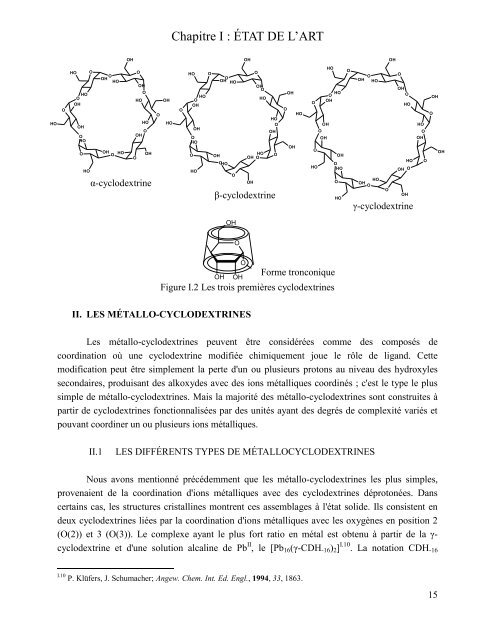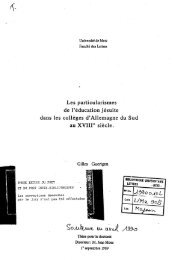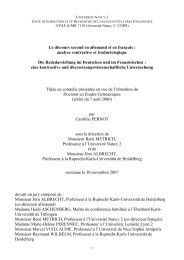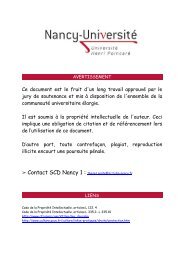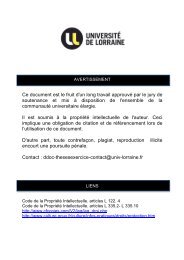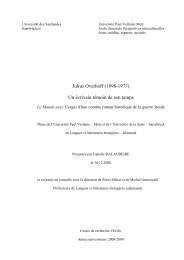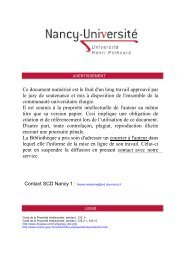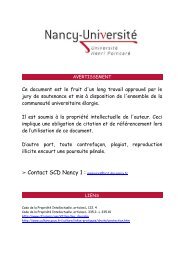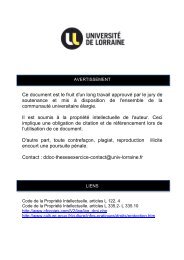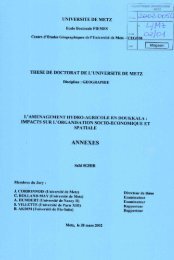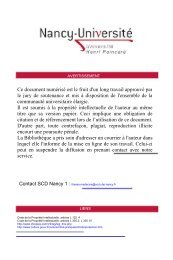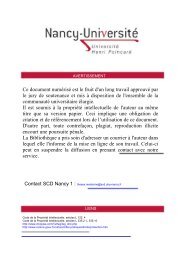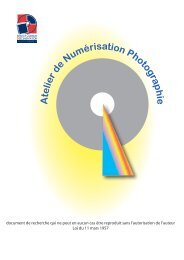Ce document est le fruit d'un long travail approuvé par le jury de ...
Ce document est le fruit d'un long travail approuvé par le jury de ...
Ce document est le fruit d'un long travail approuvé par le jury de ...
Create successful ePaper yourself
Turn your PDF publications into a flip-book with our unique Google optimized e-Paper software.
HO<br />
O<br />
HO<br />
HO<br />
O<br />
OH<br />
OH<br />
O<br />
HO<br />
O<br />
HO<br />
O<br />
O<br />
OH<br />
HO<br />
OH<br />
O<br />
HO<br />
OH<br />
O<br />
OH<br />
O<br />
HO OH<br />
HO<br />
O<br />
OH<br />
O<br />
OH<br />
α-cyclo<strong>de</strong>xtrine<br />
O<br />
Chapitre I : ÉTAT DE L’ART<br />
O<br />
OH HO<br />
Figure I.2 Les trois premières cyclo<strong>de</strong>xtrines<br />
II. LES MÉTALLO-CYCLODEXTRINES<br />
HO<br />
O<br />
HO<br />
O<br />
OH<br />
Les métallo-cyclo<strong>de</strong>xtrines peuvent être considérées comme <strong>de</strong>s composés <strong>de</strong><br />
coordination où une cyclo<strong>de</strong>xtrine modifiée chimiquement joue <strong>le</strong> rô<strong>le</strong> <strong>de</strong> ligand. <strong>Ce</strong>tte<br />
modification peut être simp<strong>le</strong>ment la perte <strong>d'un</strong> ou plusieurs protons au niveau <strong>de</strong>s hydroxy<strong>le</strong>s<br />
secondaires, produisant <strong>de</strong>s alkoxy<strong>de</strong>s avec <strong>de</strong>s ions métalliques coordinés ; c'<strong>est</strong> <strong>le</strong> type <strong>le</strong> plus<br />
simp<strong>le</strong> <strong>de</strong> métallo-cyclo<strong>de</strong>xtrines. Mais la majorité <strong>de</strong>s métallo-cyclo<strong>de</strong>xtrines sont construites à<br />
<strong>par</strong>tir <strong>de</strong> cyclo<strong>de</strong>xtrines fonctionnalisées <strong>par</strong> <strong>de</strong>s unités ayant <strong>de</strong>s <strong>de</strong>grés <strong>de</strong> comp<strong>le</strong>xité variés et<br />
pouvant coordiner un ou plusieurs ions métalliques.<br />
II.1 LES DIFFÉRENTS TYPES DE MÉTALLOCYCLODEXTRINES<br />
Nous avons mentionné précé<strong>de</strong>mment que <strong>le</strong>s métallo-cyclo<strong>de</strong>xtrines <strong>le</strong>s plus simp<strong>le</strong>s,<br />
provenaient <strong>de</strong> la coordination d'ions métalliques avec <strong>de</strong>s cyclo<strong>de</strong>xtrines déprotonées. Dans<br />
certains cas, <strong>le</strong>s structures cristallines montrent ces assemblages à l'état soli<strong>de</strong>. Ils consistent en<br />
<strong>de</strong>ux cyclo<strong>de</strong>xtrines liées <strong>par</strong> la coordination d'ions métalliques avec <strong>le</strong>s oxygènes en position 2<br />
(O(2)) et 3 (O(3)). Le comp<strong>le</strong>xe ayant <strong>le</strong> plus fort ratio en métal <strong>est</strong> obtenu à <strong>par</strong>tir <strong>de</strong> la γcyclo<strong>de</strong>xtrine<br />
et <strong>d'un</strong>e solution alcaline <strong>de</strong> Pb II , <strong>le</strong> [Pb16(γ-CDH-16)2] I.10 . La notation CDH-16<br />
I.10 P. Klüfers, J. Schumacher; Angew. Chem. Int. Ed. Engl., 1994, 33, 1863.<br />
HO<br />
O<br />
HO<br />
O<br />
OH<br />
HO<br />
O<br />
OH<br />
OH<br />
O<br />
O<br />
OH<br />
O<br />
OH OH<br />
O<br />
OH<br />
O<br />
OH<br />
O<br />
HO<br />
HO<br />
OH O<br />
OH<br />
HO<br />
O<br />
OH<br />
β-cyclo<strong>de</strong>xtrine<br />
O<br />
O<br />
OH<br />
OH<br />
HO<br />
O<br />
O<br />
HO<br />
O<br />
OH<br />
HO<br />
HO<br />
O<br />
OH<br />
OH<br />
Forme tronconique<br />
OH<br />
O<br />
HO<br />
O<br />
HO<br />
O<br />
O<br />
OH HO<br />
OH<br />
O<br />
HO<br />
O<br />
OH<br />
O<br />
OH<br />
O<br />
HO<br />
HO<br />
OH O<br />
OH<br />
γ-cyclo<strong>de</strong>xtrine<br />
HO<br />
O<br />
OH<br />
O<br />
O<br />
OH<br />
15<br />
OH


